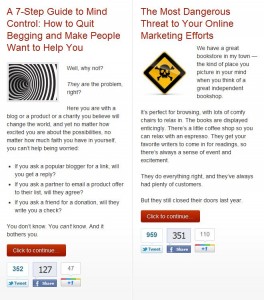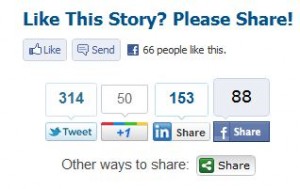|
|
TODAY.AZ / SEO & E-Marketing
Social media buttons: which ones to have on your website
29 August 2011 [13:48] - TODAY.AZ

One of the most basic lessons that exist in marketing is to make
things as simple as possible for visitors. See those buttons below?
Look pretty familiar, right?
Whether you call them buttons, icons or badges, these interactive elements that social sites provide make voting or sharing dead simple. Typically, sites either go the route of creating their own custom-designed social buttons or they add in the interactive social widgets that look like this:
While there is no right or wrong way to incorporate social media, I prefer using these interactive buttons for the following reasons.
Instantly ShareOne of the strongest cases for using these buttons is that a visitor isn’t removed from the page when he or she clicks. You act within the page or a popup.
Many of these buttons (Facebook Like, Google’s +1 and StumbleUpon) allow for instant voting, something that custom icons cannot do. Even the Facebook Share button and Twitter’s Tweet button keep people on the same page while they can perform the share in a popup. Simply put, these buttons save visitors’ time and keep them on your site.
Instantly FollowNot only can you share, you can follow. Whether it is Twitter’s Follow button or Facebook’s Like button for your Facebook fan page, interactive buttons can connect companies and fans off-site instantly. One of my pet peeves are links that say “click to Like us on Facebook” or “click to follow us on Twitter” only to send me to (and leave me at) my Facebook or Twitter page. Make it easy for your audience to connect by using the vendor badges.
Gauge Content QualityInteractive buttons also show vote and share totals, which is one factor that people can use to quickly decide what content to look at. Big numbers show popularity and, often, trustworthiness.
For example, if we have time to read only one article over at
CopyBlogger, we might take a look at the descriptions, and make my choice
based on user votes (as shown on the social badges):
So we might check out “The Most Dangerous Threat…” and save the other article for later. This is true for features and functions including extensions and downloads.
They’re UniformVisitors know what’s going to happen when they click on vendor buttons. They’re going to “like” content, “tweet” an article, or ” +1″ something, and that’s all. Custom social buttons too often leave people unsure of what will happen. Will they be taken to your company’s Facebook page? Will they be sent to Tweet via TweetMeme?
Buttons For Any SiteButtons better be interactive and have many options to choose from. Here is a short list of buttons that could work for any site:
Google +1 : This button now syncs with Google+, making it even more powerful.
Twitter’s Tweet: This allows for customization to gain more visibility for your Twitter accounts as well.
Facebook Like: This is a very versatile button that can be customizable to your liking.
Twitter’s Follow: Great for getting visitors to follow you on Twitter in one click.
StumbleUpon : If you have engaging content on your site, this button can make social bookmarking simple for people who use StumbleUpon.
/Search Engine Journal/
URL: http://www.today.az/news/seo/93328.html
 Print version
Print version
Connect with us. Get latest news and updates.
See Also
- 26 September 2025 [17:09]
Azerbaijan, Chile discuss strengthening parliamentary and bilateral ties - 02 March 2025 [21:33]
Xiaomi unveils Hyper AI techonology - 07 January 2025 [16:17]
Azerbaijani IT Institute discusses cybersecurity for drones - 02 December 2024 [19:10]
AZAL continues to offer discounts with Cyber Monday campaign - 29 November 2024 [16:49]
Jury composition for CINEMO Int'l Mobile Film Festival announced - 09 November 2024 [15:00]
Bitcoin price hits record high following Trump's win - 05 November 2024 [12:21]
Submissions for CINEMO Int'l Mobile Film Festival wraps up - 25 October 2024 [11:57]
SIMA Imza named best Biometric Digital Signature of year by Global Economics - 12 October 2024 [15:46]
Cyber attacks on Azerbaijan’s state institutions announced - 05 October 2024 [08:00]
Jabrayil City Day celebrated with festivities
Most Popular
 Erdogan’s US visit seen as potential turning point in Ankara–Washington ties [OPINION]
Erdogan’s US visit seen as potential turning point in Ankara–Washington ties [OPINION]
 Syrian court issues arrest warrant for former president Bashar al-Assad
Syrian court issues arrest warrant for former president Bashar al-Assad
 Chilean senate delegation visits Shusha and Khankendi on Remembrance Day
Chilean senate delegation visits Shusha and Khankendi on Remembrance Day
 Ministry of Economy staff honor martyrs at Victory Park on Memorial Day
Ministry of Economy staff honor martyrs at Victory Park on Memorial Day
 Nikol Pashinyan highlights importance of regional cooperation for Peace in South Caucasus
Nikol Pashinyan highlights importance of regional cooperation for Peace in South Caucasus
 Patriotic war, national dignity, eternal remembrance [OPINION]
Patriotic war, national dignity, eternal remembrance [OPINION]
 Armenian PM: I am happy to report to international community that peace established between Armenia and Azerbaijan
Armenian PM: I am happy to report to international community that peace established between Armenia and Azerbaijan



